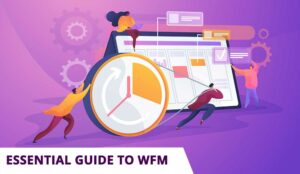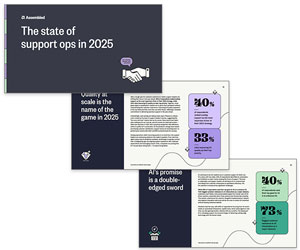Workforce management (WFM) can feel like a whirlwind of constant change. From trying to keep up with HR on training, to supporting operations with retention needs, and more, there’s often little time left to talk to IT about the features you need in your next WFM platform.
…And that’s if you even know where to start!
To make life easier, we asked WFM expert Dan Smitley to put together his essential guide to WFM features – separating the core features from the nice-to-haves – to help you make a more informed choice when comparing WFM vendors.
Forecasting
Core Features
The Ability to Consume Historical Data
Whether it’s from a copy/paste of a spreadsheet or an API connection, your WFM platform must have the ability to consume historical data.
Even if you’re working in a start-up company without much historical data to use, your WFM platform still must have the ability to consume assumed metrics (like handle time and volume) to use as a basis to create a forecast.
If your platform creates schedules but doesn’t create a historical-based forecast then you likely have a Human Resources Information System (HRIS), where some organizations store payroll, time-off requests, etc. – and not a WFM platform.
A Version of Erlang
Whether you prefer Erlang C or Erlang B, your WFM platform has to use some version of it!
Most vendors will say that they have a proprietary algorithm that they’ve developed, but most will admit that the base of it is some version of Erlang.
Ultimately, if your software cannot produce the required number of full-time equivalent (FTE) to meet your goal (service level or abandon rate) then it’s not a WFM platform.
Nice-to-Haves
Capturing Oddities for Future Use
Does your platform have a way to capture oddities in your arrival patterns and store them for use in the future?
We all need to normalize our arrival patterns to make sure we’re not inaccurately including power outages and random sales campaigns in our future forecasting. However, it’s helpful to capture those events and store them for future use.
Then, when marketing says they’re doing the Buy-One-Get-One deal again you can have a data point captured that properly increases the volume forecast based on the previous campaigns.
Multi-Variable Forecasting
It’s one thing to use historical information to create your forecast, but it’s even better when that forecast considers multiple historical variables automatically.
As an example, when forecasting for January 2027, the platform should be looking at:
- Seasonality – How big is January vs. other months in the year?
- Recent growth patterns – Is volume up year-over-year in the recent weeks/months?
- How the first week of the month differs from other weeks of the month
Platforms may allow you to self-select this information, but it’s nice to have the forecasting algorithm take care of it automatically for you.
Synchronous AND Asynchronous
More of our volume is shifting to asynchronous work (email, tickets, SMS, etc.) and some WFM vendor startups are focusing their attention there. However, we still have plenty of synchronous work (voice, chat, etc.) that legacy vendors have specialized in for years.
What you need is a platform that can do both – with a high level of accuracy and automation.
Working environments change too much to assume you won’t be adding a new channel to your forecasting before your vendor contract expires, so it’s nice to have a platform that can do both types of forecasting.
Take a look at this article for more on synchronous and asynchronous work.
Scheduling
Core Features
Matching Schedules to Forecasted Volume
The common definition of WFM is “right people, right place, right time”. This is ultimately about matching schedules to forecasted volume to minimize the impact of variable volume.
You want your scheduled number of agents to increase as your volume increases, and you want schedules to decrease as volume decreases.
If your platform produces amazing forecasts but no aligned schedules, then you likely have a data analytics platform and not a WFM platform.
Various Shrinkage Categories
Volume and handle time will get you to a base workload, but your platform needs to account for occupancy and shrinkage to get a true understanding of needed FTEs.
That shrinkage should also be able to be predicted and broken down into various buckets, such as planned vs. unplanned, and paid vs. unpaid. These differences allow you to have a more granular and accurate prediction of planned staffing levels.
Nice to Haves
Automated Self-Scheduling
Work/life balance has become a primary motivator for many people, and a large piece of that centres on schedule flexibility.
However, WFM teams don’t have to give the keys to the kingdom to agents when it comes to self-scheduling.
Your WFM platform should be able to allow agents to add/remove time from their schedules based on net staffing.
Note, your net staffing number indicates whether you’re staffed correctly. Positive net staffing means that you have too many people, whereas negative net staffing means you have too few.
This way the agents are empowered to have some control over their schedules and the company can still provide the service levels customers need.
But why stop with voluntary time off (VTO) or voluntary overtime (VTO)? Some platforms can also auto-approve paid time off (PTO) requests based on accrued PTO balances and net staffing availability.
It’s a win-win if your WFM platform can automate the approval process based on net staffing. However, if it isn’t automated and is tied to net-staffing, then your WFM team will be inundated with requests and manual adjustments that empower the agents – BUT bury your WFM team in administrative tasks.
Want to improve your scheduling? Read our article: The Top Scheduling Challenges and How to Fix Them
Real-Time Monitoring
Core Features
Real-Time Work States
Your WFM platform needs to have a direct connection to your CRM and/or your telephony platform that allows you to see an agent’s current work state vs. scheduled work state.
The real-time adherence team cannot monitor the environment if they must constantly flip between the telephony platform to see the agent state and back to the WFM platform to see the scheduled state. The two need to be tied together!
Real-Time Alarms
If the platform can see the agent’s work state, then it also needs to be able to have an alarm or notification for when an agent’s state hits a threshold.
For example, if you allow 90 seconds of after-call work (ACW) after a call, you might want a notice triggered when an agent hits 100 seconds of ACW so you can reach out to see what’s happening.
Want to make sure you are taking the best approach to real-time adherence? Read our article: 10 Tips to Elevate Real-Time Adherence
Nice-to-Haves
Intraday Reforecast
It’s one thing to be able to report what has happened today, it’s another thing to adjust the forecast based on what’s happened.
A nice to have is your WFM platform taking the actuals of shrinkage, Average Handling Time (AHT), and volume, and then reforecasting how the rest of the day is going to go.
This allows you to know, based on the latest information, if you’ll be able to meet your service level and abandon rate goals for today.
Each Contact Centre and WFM Team Is Unique

Smitley
All that’s left to say is that what one team lists as a ‘must-have’ is just a ‘nice-to-have’ for someone else.
However, hopefully, this list has highlighted how not all platforms are created equal and that you need to carefully consider software that cannot (at the bare minimum) provide the core features listed above.
Written by: Dan Smitley, WFM expert, consultant, and speaker, who has been leading WFM teams for over 15 years and is passionate about helping organizations elevate their WFM teams.
Getting new technology often requires getting stakeholder buy-in. If you are getting ready to make a purchase, read these articles next:
- Proven Ways to Get More Budget for Your Contact Centre
- What to Include in a Business Case for New Technology
- 3 Technology Mistakes That Are Probably Ruining Your Contact Centre
Author: Dan Smitley
Reviewed by: Xander Freeman
Published On: 29th Apr 2024 - Last modified: 1st Sep 2025
Read more about - Technology, Dan Smitley, Editor's Picks, Forecasting, Monitoring, Real-Time Management, Scheduling, Top Story, Workforce Management (WFM)









































